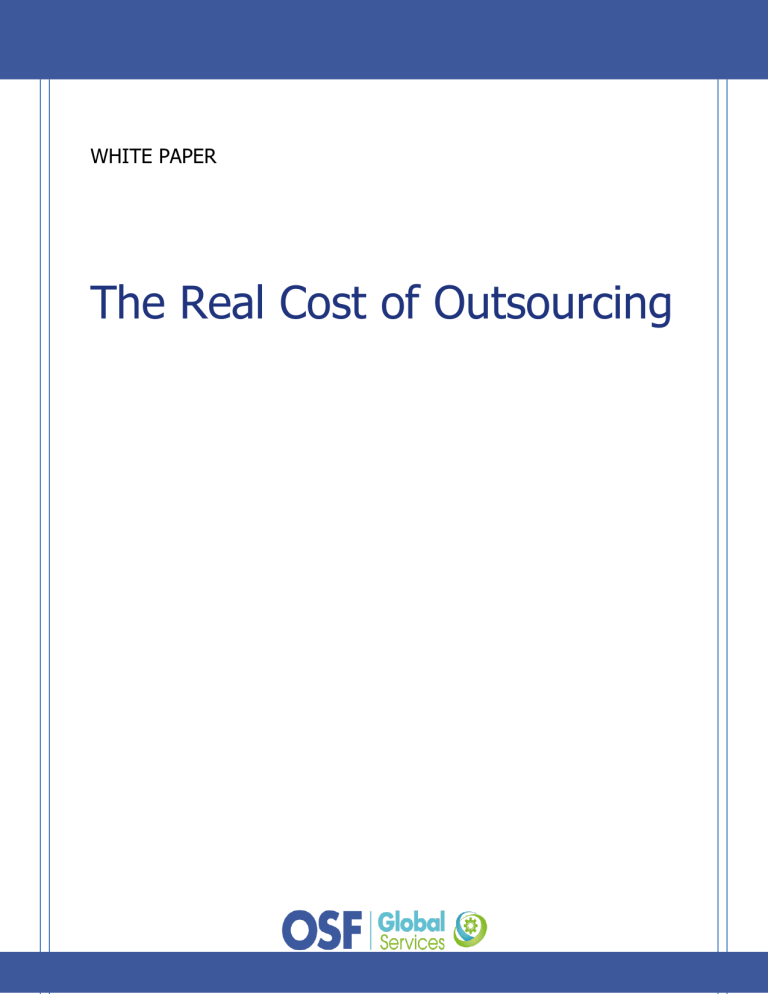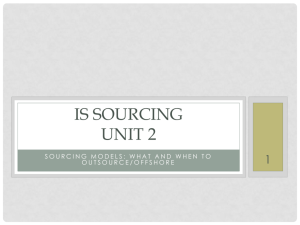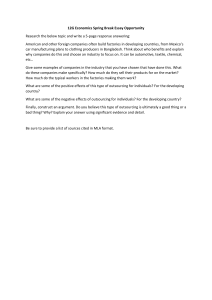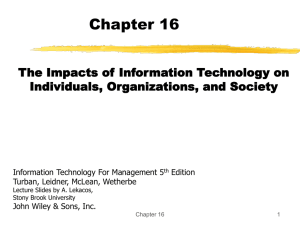
WHITE PAPER The Real Cost of Outsourcing INTRODUCTION When it comes to the figures of investing in outsourcing, statistics can give you an overall cost of ― official bills. Actually, you would be surprised to find out that the final sum up will leave your budget short with almost 65% more than estimated. This is an estimated figure according to our calculations revealed in this white paper. For quite some time, there had been claims from offshore vendors that IT work that would cost $100 an hour in the United States can be done for $20 an hour in India or China. If those figures sound too good to be true, that’s because they are. The real thing is: no one saves 80% by shipping IT work to another country. In order to find out the hidden costs of outsourcing, you should pay attention to all the figures highlighted on the following pages. TABLE OF CONTENTS Introduction Cost of Selecting the Vendor Cost of Transition Cost of Managing an Offshore Contract Let’s sum it up Conclusion www.osf-global.com © 2012 by OSF Global Services. All rights Reserved. Page 1 In this white paper, we will explore the total cost of outsourcing by uncovering the hidden figures that boost up your bill. There are areas where you will have to invest more than you thought in the beginning, issues where things like poor processes and productivity can eat away potential savings, and places where you can end up spending just as much as you would without outsourcing. The Cost of Selecting a Vendor (1-10%) With any outsourced service, the expense of selecting a service provider can vary from 0.2% to 2% in addition to Cost of Selecting the Vendor Cost of Selecting the Vendor the annual cost of the deal. These selection costs include documenting requirements, sending out RFPs and valuating the responses, and negotiating a contract. A project leader may be working full time on this, with others chipping in, and all of this represents an opportunity cost. There are also the legal fees. Some companies hire an outsourcing adviser for about the same cost as doing it themselves. To top it off, the entire process can take from six months to a year, depending on the nature of the relationship. Even when there is an existing tie between the customer and offshore vendors, the expensive and lengthy step of vendor selection is a must-do for successful outsourcing. Putting together the RFQ/RFP Distributing the RFQ/RFP and collecting the feedback Analyzing and short listing Due Diligence Management Sponsorship Decision to Outsource At this stage, travel expenses enter the picture as well. A trip overseas helps CIOs get comfortable with their choice. % Estimation: Expect to spend an additional 1 to 10% on vendor selection and initial travel costs. Choose the best sourcing model According to a study released by Gartner, many CIOs are still focused on short-term savings rather than long- term business success when establishing outsourcing relationships – and that it's costing them in the long run. www.osf-global.com © 2012 by OSF Global Services. All rights Reserved. Page 2 In order to address these issues, the organization must know that they can choose from among eight basic sourcing models to best exploit established or future capacity, whether the organization gets its services from internal staff, external staff, or through a partnership. You must take each of the following models into account before rushing to choose one vendor or another, or even before making the decision to outsource. According to a survey of 945 IT professionals, more than 50% of the respondents said they expected to see significant cost savings by outsourcing. Fewer organizations said their objective in outsourcing was to make companies more competitive in the market. Gartner Inc., 2006 8 SOURCING MODELS Internal delivery: The current status of most organizations' IT or process operations Shared service or captive center: A centralized — onshore or offshore — service organization delivering IT services or business processes for an organization, also known as an "in-sourcing" organization Full outsourcing: A single contract with one provider for the full scope of services Joint venture: A separate service company built and co-owned with an external service provider (or other client organizations in case of consortium), which is expected to provide management and expertise Best-of-breed consortium: A group of external service providers, with a lead provider established for a large contract Brand service company: A way to share IT services (and often non-IT services and processes) to leverage the market, selectively outsource parts of the services, and, in some cases, provide services to the market Selective outsourcing: Separate outsourcing contracts for selected IT functions or business processes, using a best-of-breed tactical approach and competitive deals Prime contractor: Provides management and integration of multiple service providers to derive a single or global solution or service In some sourcing arrangements — including multi-sourcing, transformational relationships, and project work — an organization may want to consider additional options to get the services it needs. Specialists suggest several sourcing options sit below the sourcing models. www.osf-global.com © 2012 by OSF Global Services. All rights Reserved. Page 3 The sourcing of technical or business skills; The sourcing of a project or a part of it; The sourcing of management; The sourcing of an IT service; The sourcing of a business process; The sourcing of a business solution, etc. Organizations can choose from these sourcing options based on their tolerance for risk and their willingness to accept or transfer management responsibility for the delivery of services. Selecting an External Service Provider requires personnel resources and access to data, key processes and procedures, generally for a short period of time. These resources are crucial to maintaining the schedule and meeting objectives. Develop and follow a formal, specific timeline for each step in the process. This timeline provides rigor, reduces costs, helps maintain enthusiasm, and provides for an overall coordination of the organizational and External Service Provider personnel who manage the process. Too many organizations, however, focus only on selecting the lowest-cost source. Organizations must institutionalize an effective and efficient process that enables the source selection team to make the best value selection–which is often not the lowest cost selection. Cost benchmarking to the current market? If the price (regarding the in-scope, requested services) is not appealing enough for the client, a typical vendor reaction is to offer fewer services, reducing the scope. The offer will include only those services for which the vendor can provide the best results, and it will simply leave the rest — by default — under the client's responsibility. This causes two major problems for the client: • The responsibility issue: The client must manage the overall service, being responsible by default for everything that will not be done by the vendor (i.e., not clearly agreed in the contract). • The cost issue: The client will incur all costs associated in both doing everything that will not be delivered by the vendor (i.e., not clearly agreed in the contract) and managing on top of the services delivered, the contract and the vendor relationship. Supplier delivery commitments. www.osf-global.com © 2012 by OSF Global Services. All rights Reserved. Page 4 Is cost/quality appropriate for services delivered, or distorted by supplier issues? Does outsourcing compare favorably against in-house service delivery? Are internal contract management costs and time appropriate? The Cost of Transition (2-3%) The transition period is perhaps the most expensive stage of an offshore endeavor. It takes from three months to a full year to completely hand the work over to an offshore partner. If company executives aren’t aware that there will be no savings — but rather significant expenses — during this period, they are in for a nasty surprise. Costs of transition are typically bundled into the cost of the overall outsourcing deal. However, in the case of complex BPO involving migration to new IT platforms and systems, which is more than labor arbitrage, Gartner sees separate contracts drawn up to cover these costs. Best practice is for a single comprehensive plan of activities to be created and used as the master plan for the entire transition. The greater the complexity, the higher the transition cost. Costs retained by the client must also be factored into the business case when contemplating an outsourcing deal. CIOs must bring a certain number of offshore developers to their headquarters to analyze the technology and architecture before those developers can head back to their home country to begin the actual work. And CIOs must pay the prevailing home country hourly rate to offshore employees on temporary visas, so obviously there’s no savings during that period of time, which can take months. And the offshore employees have to work in parallel with similarly costly in-house employees for much of this time. Basically, it’s costing the company double the price for each employee Cost of Transition Transition project management Third-party consultant oversight (if outside verification and validation is needed) Communications (resources to write, manage and facilitate, as well as the potential use of public relations firms to communicate outsourcing deal/transition messages to the public) Human capital management (can include severance, outplacement, retention bonuses, "reskilling" and hiring costs) Legal fees (interpretation of the contract, thirdparty contracts, established vendor contracts if an interface is needed with the new provider) Technical costs (development/integration costs to new interfaces, porting of code to new platforms) assigned to the outsourcing arrangement (the offshore worker and the in-house trainer). In www.osf-global.com © 2012 by OSF Global Services. All rights Reserved. Page 5 addition, neither the offshore nor in-house employee is producing anything during this training period. During the transition, the offshore partner must put infrastructure in place. While the offshore partner incurs that expense, the customer should monitor the process carefully. Often it can take longer than expected. % Estimation: Expect to spend an additional 2% to 3% on transition costs. Hidden Costs of Transition: The Cost of Layoffs – laying off employees as a result of your offshore contract – poses other sometimes unanticipated costs. To begin with, you have to pay many of those workers severance and retention bonuses. Layoffs can also cause major morale problems among in-house "survivors," in some cases leading to disaffection and work slowdowns. Companies with experience in offshoring factor productivity dips and potential legal action from laid-off employees into the cost-benefit analysis. %Estimation: Expect to pay an extra 3% to 5% on layoffs and related costs. The Cultural Cost - One of the biggest impediments to offshore savings is productivity. You simply cannot take a person in your home country and easily replace him/her with one offshore worker. One reason for that is the home country workers’ comfort level with speaking up and offering suggestions. Another productivity killer is high turnover at offshore vendors. Attrition rates climb as high as 35% in India, according to the National Association of Software and Service Companies. Turnover can cost an additional 1% to 2%. Finally, communication issues can slow things to a halt. Language and other cultural differences can cost an extra 2% to 5%. % Estimation: Expect to spend an extra 3% to 27% on productivity lags. The Cost of Ramp-up (ensuring quality, processes and procedures) Well-defined and accepted internal software development and maintenance processes are also key to making an offshore situation work. If a company doesn’t create solid in-house processes, the vendor will have to put more people on site to compensate for your inadequacies, and they’ll spend all of your savings. www.osf-global.com © 2012 by OSF Global Services. All rights Reserved. Page 6 The ability to write clear specifications is also critical to achieving offshore savings. Creating a great spec package is costly and time-consuming. On a 1,000 man-hour project for example, the staff will spend 100 hours to create a spec package. At the other end of the process is quality assurance (QA) testing, an area which must become more robust in an offshore arrangement. % Estimation: Expect to spend an extra 1% to 10% on improving software development processes. The Cost of Managing an Offshore Contract (6-10%) Managing the actual offshore relationship is also a major additional cost. There's a significant amount of work in invoicing, in auditing, in ensuring cost centers are charged correctly, in making sure time is properly recorded. Each project manager oversees the effort. He audits the time sheets from the vendor and rolls the figure into an invoice, which then has to be audited against the overall project, which is then funneled to finance for payment. Sometimes, managing the offshore vendor is such a big task that you have to assign someone to handle it on a half-time basis. The individual must make sure projects move forward, and develop and analyze vendor proposals against the RFPs when it comes time to bid out new work. % Estimation: Expect to pay an additional 6% to 10% on managing your offshore contract. Sum it up What we skipped in mentioning so far are the well-known standard costs of outsourcing that every company will provide you. That is because we wanted to emphasize the tricky hidden costs that will give you a more realistic view on how much outsourcing will bite from your budget. The IT research company, Gartner, provides us with the following standard figures in percentages of what you must specify in the contract about payment. Furthermore we add another table with what we have outlined on the previous pages. Therefore you can see that the real costs you pay for outsourcing is somewhere between 13-65% higher than you think in the beginning. www.osf-global.com © 2012 by OSF Global Services. All rights Reserved. Page 7 Here are the Gartner figures. Average Total Cost of Outsourcing Outsourcing Charging Document %age of Average Enterprise IT Delivery Costs Service provider’s delivery costs 60% Service provider’s account management 6% 6% (legal, human resources, administration) Transferred overhead 20% (typically varies between 18-28% for longterm, full-scope IT outsourcing deals) Service provider’s gross profit Financial engineering included in price 3% (this can be significantly higher when substantial upfront payments, funding for significant initial cost reduction or funding for transformation projects are bundled into the price) Risk premium included in the price 6% (can be as high as 15%) Deal management by the customer 5% (the total cost of management can be twice this for more complex deals or deals experiencing significant change TOTAL 100% Source: Gartner Research www.osf-global.com © 2012 by OSF Global Services. All rights Reserved. Page 8 And let’s see what the extras are. Estimated Additional Costs Outsourcing Hidden Costs %age of Total Costs The Cost of Selecting a Vendor 1-10% The Cost of Transition 2-3% The Cost of Layoffs 3-5% The Cultural Cost (productivity) 3-27% The Cost of Ramp-up 1-10% The Cost of Managing the Contract 6-10% TOTAL 13-65% Conclusion The estimation of costs it’s a crucial stage in deciding whether, how, and what to outsource. You must take into consideration every single aspect that might boost your bill. And what’s more important, instead of focusing on low cost when choosing an outsourcing partner, you will gain more by looking at the bigger picture, and scrutinizing if the firm has the necessary resources and the ability to deliver. The firm should be a part of the strategic decisions taken by the parent company and commitments should be based on long-term returns that benefit the business as a whole rather than just saving on short-term costs. www.osf-global.com © 2012 by OSF Global Services. All rights Reserved. Page 9


